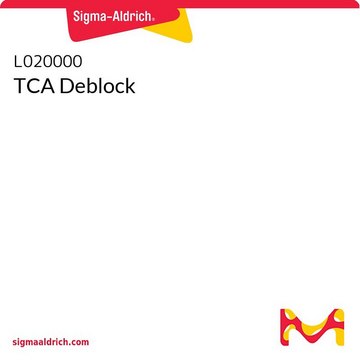707066
DCA Deblock (0.36M dichloroacetic acid in toluene)
Sinónimos:
DCA Deblock, DEBLOCK (0.36M dichloroacetic acid in toluene)
About This Item
Productos recomendados
form
liquid
Quality Level
concentration
≤100 ppm in H2O
bp
110-111 °C
density
0.884 g/mL at 25 °C
SMILES string
OC(=O)C(Cl)Cl
InChI
1S/C2H2Cl2O2/c3-1(4)2(5)6/h1H,(H,5,6)
InChI key
JXTHNDFMNIQAHM-UHFFFAOYSA-N
¿Está buscando productos similares? Visita Guía de comparación de productos
Categorías relacionadas
General description
Application
signalword
Danger
Hazard Classifications
Aquatic Chronic 3 - Asp. Tox. 1 - Carc. 2 - Eye Dam. 1 - Flam. Liq. 2 - Lact. - Repr. 1B - Skin Irrit. 2 - STOT RE 2 Inhalation - STOT SE 3
target_organs
Central nervous system
Storage Class
3 - Flammable liquids
wgk_germany
WGK 3
flash_point_f
41.0 °F
flash_point_c
5 °C
ppe
Faceshields, Gloves, Goggles, type ABEK (EN14387) respirator filter
Elija entre una de las versiones más recientes:
¿Ya tiene este producto?
Encuentre la documentación para los productos que ha comprado recientemente en la Biblioteca de documentos.
Nuestro equipo de científicos tiene experiencia en todas las áreas de investigación: Ciencias de la vida, Ciencia de los materiales, Síntesis química, Cromatografía, Analítica y muchas otras.
Póngase en contacto con el Servicio técnico












